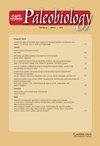长时间的发育可塑性:种群生态推断的窗口
IF 2.6
2区 地球科学
Q2 BIODIVERSITY CONSERVATION
引用次数: 2
摘要
摘要发育可塑性,即性状根据环境变化而改变状态,在现代人群中得到了很好的研究。它也被怀疑在宏观进化动力学中发挥作用,但由于缺乏长期记录,可塑性主导的深度进化的频率仍然未知。种群是动态的实体,但它们在化石记录中的表现往往是孤立个体的静态快照。在这里,我们首次将当代整体投影模型(IPMs)应用于化石数据,以将个体发展与预期的种群变化联系起来。ipm描述了个体生长对长期种群动态的离散步骤的影响。我们使用浮游有孔虫三叶虫的现代和化石资料来参数化模型。有孔虫通过在离散阶段增加腔体而生长,并在繁殖时死亡,这使它们成为ipm的极好研究案例。我们的研究结果预测,体细胞生长速率对种群动态的影响几乎是生存的两倍,是繁殖的八倍多,这表明选择主要针对体细胞生长作为适应性的主要决定因素。随着许多古生物系统记录单个遗传个体的生长速率增量和成像技术的日益可用,我们的研究结果为跨越宏观进化动力学的发育可塑性的循证推断提供了可能性。考虑到生态学在古生物学思想中的中心地位,我们的模型是一种帮助跨越生态进化尺度的方法,同时将注意力引向最相关的生活史特征来测量。本文章由计算机程序翻译,如有差异,请以英文原文为准。
Developmental plasticity in deep time: a window to population ecological inference
Abstract. Developmental plasticity, where traits change state in response to environmental cues, is well studied in modern populations. It is also suspected to play a role in macroevolutionary dynamics, but due to a lack of long-term records, the frequency of plasticity-led evolution in deep time remains unknown. Populations are dynamic entities, yet their representation in the fossil record is a static snapshot of often isolated individuals. Here, we apply for the first time contemporary integral projection models (IPMs) to fossil data to link individual development with expected population variation. IPMs describe the effects of individual growth in discrete steps on long-term population dynamics. We parameterize the models using modern and fossil data of the planktonic foraminifer Trilobatus sacculifer. Foraminifera grow by adding chambers in discrete stages and die at reproduction, making them excellent case studies for IPMs. Our results predict that somatic growth rates have almost twice as much influence on population dynamics than survival and more than eight times more influence than reproduction, suggesting that selection would primarily target somatic growth as the major determinant of fitness. As numerous paleobiological systems record growth rate increments in single genetic individuals and imaging technologies are increasingly available, our results open up the possibility of evidence-based inference of developmental plasticity spanning macroevolutionary dynamics. Given the centrality of ecology in paleobiological thinking, our model is one approach to help bridge eco-evolutionary scales while directing attention toward the most relevant life-history traits to measure.
求助全文
通过发布文献求助,成功后即可免费获取论文全文。
去求助
来源期刊

Paleobiology
地学-古生物学
CiteScore
5.30
自引率
3.70%
发文量
38
审稿时长
>12 weeks
期刊介绍:
Paleobiology publishes original contributions of any length (but normally 10-50 manuscript pages) dealing with any aspect of biological paleontology. Emphasis is placed on biological or paleobiological processes and patterns, including macroevolution, extinction, diversification, speciation, functional morphology, bio-geography, phylogeny, paleoecology, molecular paleontology, taphonomy, natural selection and patterns of variation, abundance, and distribution in space and time, among others. Taxonomic papers are welcome if they have significant and broad applications. Papers concerning research on recent organisms and systems are appropriate if they are of particular interest to paleontologists. Papers should typically interest readers from more than one specialty. Proposals for symposium volumes should be discussed in advance with the editors.
 求助内容:
求助内容: 应助结果提醒方式:
应助结果提醒方式:


